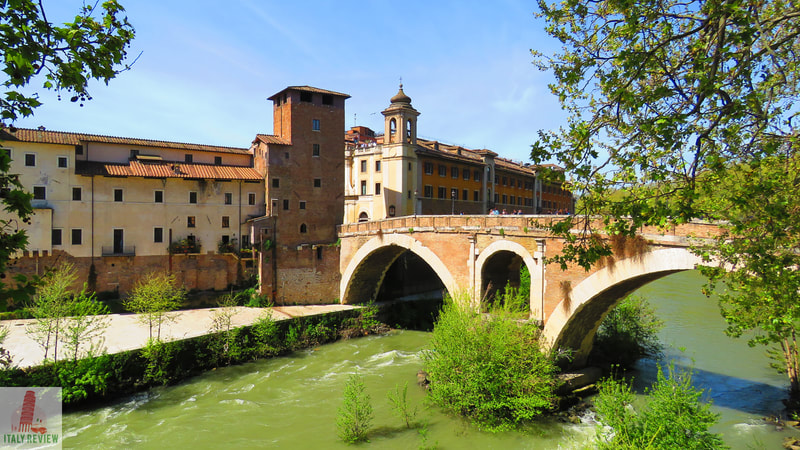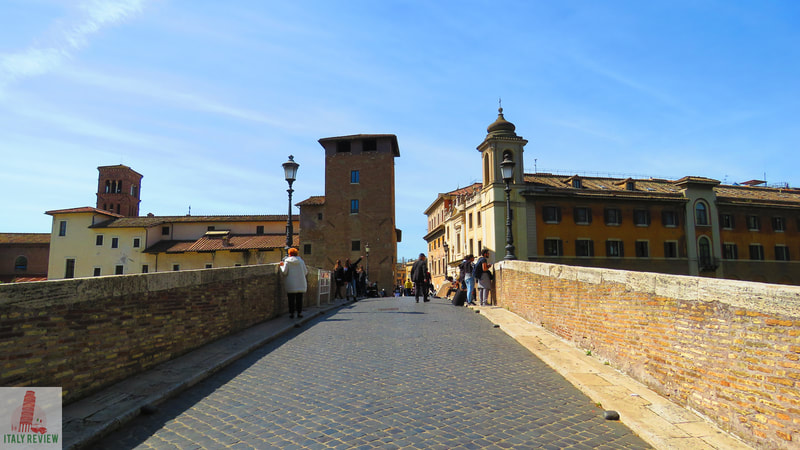Ponte Fabricio
|
By Dion Protani
|
Latest update: 23 January 2024
|
|
The Ponte Fabricio is the oldest bridge in Rome, built in 62 BC. It spans the short distance from the north bank of the River Tiber to the little island that sits in the middle of it called Isola Tiberina.
The originally-titled Pons Fabricius measures 62 metres in length which is slightly longer than the 54 metre long Ponte Cestio which completes the crossing from Isola Tiberina to the south bank. |
Related links
Profile
The Ponte Fabricio, also known as the Ponte dei Quattro Capi, is one of the oldest and most well-preserved ancient Roman bridges in Rome, Italy. It spans the Tiber River, connecting the Tiber Island (Isola Tiberina) with the Trastevere district on the western bank.
The Ponte Fabricio is a stone bridge with a single arch that spans about 62 meters in length and 5.5 meters in width. Its distinctive arch shape is an example of ancient Roman engineering expertise, and the bridge's structure has remained virtually unchanged since its construction. The stone parapets on the sides of the bridge give it a classic and elegant appearance.
The bridge provides stunning views of the Tiber River and its surroundings, making it a popular spot for tourists and locals to enjoy a leisurely stroll while taking in the picturesque scenery of Rome.
The Ponte Fabricio is a stone bridge with a single arch that spans about 62 meters in length and 5.5 meters in width. Its distinctive arch shape is an example of ancient Roman engineering expertise, and the bridge's structure has remained virtually unchanged since its construction. The stone parapets on the sides of the bridge give it a classic and elegant appearance.
The bridge provides stunning views of the Tiber River and its surroundings, making it a popular spot for tourists and locals to enjoy a leisurely stroll while taking in the picturesque scenery of Rome.
History
The construction of the Ponte Fabricio dates back to 62 BC during the late Roman Republic period. It was commissioned by Lucius Fabricius, a high-ranking Roman official, and it was originally named after him. The bridge was built to facilitate access to the Tiber Island, which was an important center for religious and medical practices in ancient Rome.
During the Middle Ages, the bridge was partially reconstructed and modified, but the original Roman arch remained intact. Over the centuries, the Ponte Fabricio has endured floods, wars, and natural disasters, yet it has stood as a testament to Roman engineering resilience.
During the Middle Ages, the bridge was partially reconstructed and modified, but the original Roman arch remained intact. Over the centuries, the Ponte Fabricio has endured floods, wars, and natural disasters, yet it has stood as a testament to Roman engineering resilience.
Key features and nearby attractions
- Location: The bridge is located near the Tiber Island and connects the Jewish Ghetto area of Rome with the Trastevere district. It is easily accessible on foot from various parts of the city.
- Historical Significance: The Ponte Fabricio is not only an ancient Roman bridge but also one of the few remaining structures from antiquity that still serves as a functional bridge in Rome.
- Walking Tour: Consider joining a guided walking tour of Rome that includes the Ponte Fabricio, where knowledgeable guides can provide historical context and insights.
- Nearby Attractions: The bridge is within walking distance of other popular tourist attractions in Rome, such as the Roman Forum, the Colosseum, and the Piazza Venezia.
- Nighttime Illumination: The bridge is beautifully illuminated at night, creating a romantic and atmospheric setting for an evening stroll.
Pons Fabricius/Ponte dei Quattro Capi
|
City: Rome
Province: Metropolitan City of Rome Region: Lazio Built: 62 BC Architectural style: Ancient Roman Length: 62 metres Crosses: River Tiber Fly to: Rome Fiumicino Airport - 27 minutes by car (27 km) Close by: Circus Maximus, Baths of Caracalla, Il Vittoriano Recommended accommodation: Hotel Artemide |
UNESCO World Heritage Site
Historic Centre of Rome, the Properties of the Holy See in the City Enjoying Extraterritorial Rights and San Paolo Fuori le Mura
Year: 1980
Historic Centre of Rome, the Properties of the Holy See in the City Enjoying Extraterritorial Rights and San Paolo Fuori le Mura
Year: 1980























